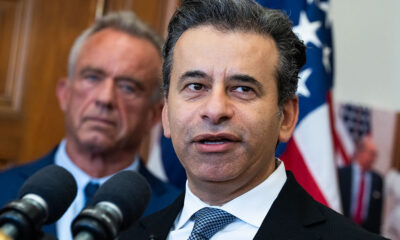World
Trump and Xi Reach Temporary Agreement on Rare Earth Exports

U.S. President Donald Trump and Chinese President Xi Jinping recently engaged in high-stakes discussions that led to a temporary agreement over the contentious issue of rare earth exports. Following their meeting, Trump expressed optimism, stating the two leaders had “settled” their differences regarding access to China’s vital rare earth minerals. During a flight aboard Air Force One, he remarked, “There’s no roadblock at all on rare earth. That will hopefully disappear from our vocabulary for a little while.”
This agreement allows China to delay implementing new export controls on critical minerals for a period of one year. These minerals are essential for various industries, including electronics and defense. Despite Trump labeling this a win for global economic stability, the situation remains precarious, as existing export restrictions from China continue to impact U.S. and international companies reliant on these materials for manufacturing fighter jets, semiconductors, and electric vehicles.
The negotiations highlighted a significant shift in bargaining power. To secure China’s concession, the U.S. agreed to postpone the expansion of its export blacklist, which would have affected thousands of Chinese firms. More than 24 hours post-meeting, the White House had yet to release a detailed account of the discussions, while the Chinese commerce ministry provided documentation outlining the agreement.
U.S. Trade Representative Jamieson Greer acknowledged that the negotiations did not lead to a reduction in China’s existing export controls. He indicated that the deal primarily serves as a continuation of prior commitments, which have been inconsistently honored by Beijing. “We expect there to be more of a Chinese general approach,” Greer stated.
Concerns Over Long-Term Implications
Critics of the negotiations express skepticism regarding the effectiveness of this temporary pause. They argue that the U.S. has inadvertently accepted a negotiating link between its own restrictions on high-tech exports, such as artificial intelligence chips, and China’s rare earth policies. Chris McGuire, a former National Security Council member, warned that this could set a “dangerous precedent,” as it illustrates a retreat from previously established positions.
The U.S. has been navigating a delicate balance in its trade relations with China, especially following Beijing’s introduction of new export restrictions for rare earth magnets in April 2025 and the announcement of broader controls in early October. This backdrop of tit-for-tat exchanges has complicated the trade landscape leading up to the recent meeting.
Although Trump sought to leverage the situation by suggesting aggressive measures like a 100% tariff increase, he ultimately retreated from that stance. In addition to postponing the expanded blacklist, the U.S. has also halted tariffs imposed due to China’s involvement in the fentanyl trade, providing further concessions to Beijing.
Evaluating Industry Impact
The ramifications of these negotiations extend beyond mere political maneuvering. Industries reliant on rare earth elements are left in a vulnerable position. Wade Senti, president of Advanced Magnet Lab Inc., emphasized that despite the ceasefire on new controls, the fundamental landscape for industries dependent on these resources remains unchanged. He noted, “The risk for the military I don’t think, quite frankly, has changed since the beginning of June.”
As companies continue to navigate a complex approval process for rare earth exports, the impact is felt internationally. Firms in countries such as Germany are facing similar bureaucratic hurdles, as Beijing requires extensive documentation for export licenses. The recent delay in China’s more stringent controls may provide temporary relief, but the underlying issues persist.
While the U.S. administration has framed this agreement as a victory for the global supply chain, experts caution that the concessions made could benefit China more in the long run. The temporary nature of the pause raises questions about its effectiveness in ensuring a stable supply of critical resources.
The evolving relationship between the U.S. and China in the realm of rare earth exports reflects broader economic and political dynamics that will continue to shape global trade. As both nations prepare for further discussions in 2026, the outcome of these negotiations will be closely scrutinized by industry leaders and policymakers alike.
-

 Science2 weeks ago
Science2 weeks agoResearchers Challenge 200-Year-Old Physics Principle with Atomic Engines
-

 World1 week ago
World1 week agoBoeing’s Aircraft Production: Assessing Numbers and Challenges
-

 Politics2 weeks ago
Politics2 weeks agoNHP Foundation Secures Land for 158 Affordable Apartments in Denver
-

 Lifestyle6 days ago
Lifestyle6 days agoTrump’s Push to Censor National Parks Faces Growing Backlash
-

 Lifestyle1 week ago
Lifestyle1 week agoRed Bluff High School’s Elli Nolan Named Rotary Student of the Month
-

 Science1 week ago
Science1 week agoAI Misidentifies Doritos Bag as Gun, Triggers Police Response
-

 Entertainment7 days ago
Entertainment7 days agoSyracuse Stage Delivers Lively Adaptation of ‘The 39 Steps’
-

 Health2 weeks ago
Health2 weeks agoNeuroscientist Advocates for Flag Football Until Age 14
-

 Lifestyle2 weeks ago
Lifestyle2 weeks agoLongtime Friends Face Heartbreak After Loss and Isolation
-

 Politics6 days ago
Politics6 days agoNFL Confirms Star-Studded Halftime Show for Super Bowl LVIII
-

 World2 weeks ago
World2 weeks agoGlobal Military Spending: Air Forces Ranked by Budget and Capability
-

 Health2 weeks ago
Health2 weeks agoFDA Launches Fast-Track Review for Nine Innovative Therapies









